As a head coach, Jim Curtin has been refreshingly honest in his pre- and post-game chats. Perhaps that is why it was so disappointing to hear him say, “I think we created enough chances to get the result tonight” after Saturday’s 1-1 tie in Chicago. The Union generated one non-penalty shot on goal (that should have resulted in a penalty) and only managed to earn a point through a call so bad it may require Spinal Tap logic to put an accurate number in the Geiger Counter.
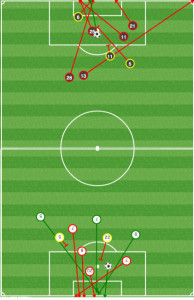
Top: Union shots (Casey’s flicked header that hit Shipp’s hand counted as Blocked Shot). Bottom: Fire shots
Perhaps that’s too harsh on Curtin. He may, in fact, be right. Philadelphia generated one real chance, but Chicago did not generate any from open play. The Fire’s only two threats came from a Jeff Larentowicz warning shot off a corner in the 37th minute and then the real deal in the 60th. Aside from the big center midfielder’s two headers, the Fire failed to put a shot on net inside of 25 yards. Quincy Amarikwa’s mazy dribble into the box from the right endline was the biggest scare on a night when the most offensive thing on the field was the referee’s performance.
Star performers
Sometimes defenders win Man of the Match awards for a highlight reel showcasing diving shot blocks, furious scrambling defense, and perhaps a goalline clearance. Maurice Edu and Ethan White did none of those things on Saturday, but they were far and away the team’s best players.
Edu’s transition into the back has been marked for its absence of the typical midfielder conversion: No anxious early retreats that break the offside line, no chasing down a player on the wing when the mind reverts into defensive midfield mode, and no barely controlled desire to turn himself into an extra-deep lying playmaker. Edu glides around the back making simple plays by taking direct, smart routes to the ball. He is physical away from goal and cautious in the box.
White has shown an aerial game that is far better than advertised, and Curtin was right to note that the player has shown an excellent long passing game since shaking off any rust acquired while waiting in the doghouse for his opportunity.
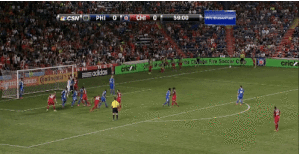
Though for all the positive things you can say about the Union defense, set pieces remain a problem. (Click to play)
The Union central defenders paired with Amobi Okugo and Michael Lahoud to bracket Mike Magee and make him a non-entity from the start (8/14 passing in his own half for Magee, leading many to wonder if he was filming a follow-up to this hilarious video Saturday night while the rest of his team was playing a soccer match). With Chicago deploying two deep central midfielders, Magee’s absence left Quincy Amarikwa to huff and puff at White and Edu all on his lonesome, which basically meant fans got to see a lot of Mo Edu’s ever-hilarious bemused smile as he casually dealt with the energetic attacker.
Speaking of bemused…
Many fans may have had the same reaction watching Danny Cruz’s performance. The player who has been quite effective this season as a wide outlet spent much of the match in a narrow role that opened Chicago’s only real route forward.
Cruz was so consistently narrow that one has to be curious about whether he was instructed to stay central defensively. Unfortunately, this tactic (whether it came from the coaching staff or the player himself) left a lane up the left side of the Union defense that Alex and Lovell Palmer, and Grant Ward, used to overload Ray Gaddis and create space for crosses.
Luckily, the Fire are not very good, Edu and White were very good, and the weight placed on Philadelphia’s pressure point came to nothing.
On the other side, Sebastien Le Toux was putting on possibly his most complete performance all season. In his role as a hybrid striker/wide attacker, Le Toux has tended to drift in and out of games, though he often manages to pop up at opportune moments.
The Frenchman was a more stable presence on Saturday, tracking back hard to keep Harry Shipp in check. This defensive work ensured that Okugo was not pulled wide, which would have opened a base of operations in front of the back line for Mike Magee.
The other notable feature of Le Toux’s performance was his improved commitment to team shape. Philly has adopted a more compact structure under Jim Curtin, and Le Toux and Danny Cruz — both incessantly aggressive — have had the steepest learning curve.
In recent games, Le Toux has worked well with Cristian Maidana to switch roles and fill gaps defensively, then return to more dangerous positions in transition. With Nogueira taking up Maidana’s free role, Le Toux remained dedicated to dropping into a good defensive shape, though the Union as a team were forced to be more aggressive as Chicago’s game plan became apparent.
Weathering the storm in the Windy City
It had to happen eventually. Sell out on the counterattack long enough and you will run into a team that shrugs, folds their arms, and refuses to throw enough numbers forward to make a dangerous counterattack likely. The Fire played with Larentowicz and Matt Watson sitting close to the back four and only released Lovel Palmer upfield once Alex had possession deep in the Philadelphia half. The dreary contest that played out made two things abundantly clear.
First, the league (or at minimum, Frank Yallop) realizes that Philly’s transition offense is for real. Even without Cristian Maidana, the Union pushed a midfielder high when they won the ball and looked to play through Nogueira at pace. The talented footsmith may not take players on like his Argentinian counterpart, but his vision and passing range allow him to do for the Union what David Beckham used to do for LA Galaxy so well: Put dangerous players in dangerous positions.
Second — and Yallop definitely realized this — the Union do not have an adequate fall back plan. Jhon Kennedy Hurtado was going to play rough with Conor Casey until Geoff Gamble used his front pocket back the defender off. Without Casey bringing numbers into play on the offensive end, Philadelphia’s offense stalled out looking for a Plan B.
Compare the incomplete passes of Brian Carroll, Vincent Nogueira, Cristian Maidana, and Fred against New York to Nogueira, Okugo, Lahoud, and Fred against Chicago. It is less important that the latter group made more incomplete passes than it is that more of their incomplete passes are short attempts to connect with other players in the middle. Forced to play a creative possession game by a conservative defense, the Union did not answer the bell. Add the defense and wingers to that field and you see an even clearer pattern of misplaced short passes.
Why? There is no single reason, of course. But we can identify a few likely culprits. Calling Vincent Nogueira a culprit for being a hard worker seems harsh, however the Frenchman’s habit of trying to do it all means he is a step or two slower to transition to an offensive role than Maidana. The finger can also be pointed at the rest of the Union’s central midfield triangle. The amount of overlap between Okugo and Lahoud can be seen as a blessing and a curse. While they combine to provide excellent defensive protection, neither player steps forward to create depth when the Union have the ball.
Nogueira, on the other hand, is wonderful at creating depth. Once the Union were operating with Fred in front of Lahoud and Nogueira, they were more dangerous because Nogueira would step a few yards ahead of Lahoud, meaning that when the two players connected, they were moving the ball past defenders rather than merely sideways. In contrast, Okugo and Lahoud tend to be side by side when passing, leading to the same problems that plagued the Edu-Carroll partnership earlier this season.
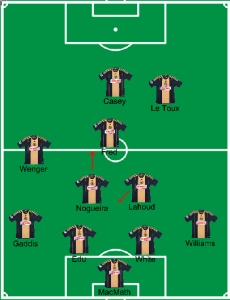
When the Union have the ball, Nogueira steps forward to invert the midfield triangle, creating depth in the short passing game.
Looking ahead
Unfortunately, this match — and the Union’s recent form in general — may muddle the future rather than simplifying it. Maurice Edu has been stellar in the back, but Carlos Valdes’ impending arrival probably means either Edu or White will make way for the former All-Star. White, failure to step to Bradley Wright-Phillips aside, has been revelatory, and he is a natural central defender. Jim Curtin has a big decision to make when (if? Are we still pretending?) Valdes is finally available for selection.
And that decision will have ripple effects in the midfield. On current form, a healthy Maidana and Nogueira should be locked into two of the three central midfield roles. That leaves Okugo, Lahoud, Carroll (?) and possibly Edu with one spot to fill. Okugo and Edu fit the role beside Nogueira best, offering the defensive discipline and passing range that can free the Frenchman up to cheat out to the wings in transition. Okugo should have made the position his by now. Instead, his uncertainty in joining the attack coupled with a lack of post-match discipline mean the young midfielder has not made the most of his long-awaited opportunity in midfield.
With a road match against the defensively excellent Sporting Kansas City on the horizon, the Union have a chance to see how big of a fish their all-out transition game can hook. The answer will come from the center of the pitch.
Player ratings
Zac MacMath – 6
Not asked to do much, MacMath slapped one cross, almost creating a dangerous situation. He was quick off he line and did well to close down Amarikwa when the attacker rounded Edu in the second half.
Raymon Gaddis – 6
Another solid performance from a player that will win you over soon if he hasn’t already. Even without cover on his side, he kept the Fire from getting into the box, forcing a series of unsuccessful crosses out of the corner. My favorite part of Gaddis’ game though? He plays with a chip on his shoulder. Not a wild-tackling, something-to-prove chip. The kind of chip where every moment of every game is a the moment, and he wants to be on top for all of them.
Ethan White – 8
Another strong, consistent showing from a guy that was seen slightly less than a unicorn under John Hackworth. His aerial game and passing range have been better than anyone could have hoped, and he has worked well with the calm presence of Edu. To date, White has played behind two defensive mids. When Maidana and Nogueira are both healthy, that could change. It will be interesting to see how he will adapt with slightly less cover in front.
Maurice Edu – 8
If only he had nailed that volley… But even so, Edu put on another clinic in the back. He was beaten once on the endline by Amarikwa, but otherwise he hardly put a foot wrong. It seems to calm the Union to have Edu in the back, and the team shape has been much improved since he switched positions.
Sheanon Williams – 7
Pushing up the wing forced Harry Shipp to play a bit more defense than he wanted to. Sheanon was aggressive and again got his head onto a corner kick. He is a player rounding into form.
Michael Lahoud – 6
An efficient performance in which he rarely strode forward. Lahoud locked down the middle of the pitch and positioned himself excellently throughout. The only knock on Lahoud right now is unfortunately a big one: He is prone to giveaways in his own half. For a fanbase that has seen a team pay dearly this year for individual errors, Mike Lahoud makes you hold your breath.
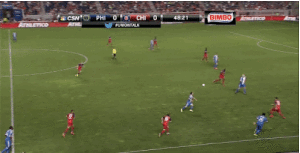
When the ball pops out, Okugo has not moved up to fill the space, meaning the Union left a gap between the front five and back five. Chicago nearly took advantage. (Click to play)
Amobi Okugo – 5
It is not that Okugo was bad. It’s just that he remains hesitant to assert himself on the game. Currently, it seems like Okugo has an acute case of Michael Farfan Syndrome. After his breakout rookie season, Farfan was moved to the middle of the park. Where he was… decent. It was always noticeable how Farfan would check to the ball as a central mid. He did it languidly, borderline casually. In contrast, Roger Torres was always easy to spot for how hard he checked to and demanded the ball. That assertiveness — that recognition and acceptance that you are the player who should have the ball — needs to return to Okugo’s game.
Vincent Nogueira – 7
Dangerous as ever when he picked his head up, Nogueira was less disciplined than Maidana had been before him. He tended to turn the defensive 4-5-1 into a 4-4-2, leaving a gap in front of Okugo and Lahoud. As usual, he seemed more in control once he moved to a deeper role to accommodate Fred.
Danny Cruz – 5
For the consistency with which it happened, I’m going to assume Cruz was told to stay narrow. It didn’t make sense, but it was just too darn… consistent to be pure “drifting” on Cruz’s part.
Sebastien Le Toux – 8
Buried another penalty, and this one was earned by his performance. Le Toux’s energetic tracking back was crucial, as the Union muted Harry Shipp from start to finish. He was less effective in the offensive game without the usual quick counters, but he put pressure on the fullbacks by chasing and got himself a couple good looks on goal in the process.
Conor Casey – 6
Should have earned a penalty when Shipp pushed his header around goal with an elbow. Otherwise a less influential hub than in recent games. Hurtado put the pressure on the referee to call the rough stuff, and for the most part he didn’t. As a result, Casey was doing more dirty work than distributing.
Andrew Wenger – 5
A very strong defensive shift, but only 6/10 passing and not generating a cross or a shot is a bit below what the Union need from an offensive substitution.
Fred – 6
Again, not negative performance, but less influential than hoped. Fred’s crowning moment was a spectacular lung bursting defensive run to clear danger when Amarikwa was driving at goal late in the match.
Brian Brown – 6
Not enough time to do much good or bad. Brown had a fair penalty call when Hurtado shouldered him off the ball in the box, though no complaints about Gamble’s decision to play on.
Geiger counter
Geoff Gamble – 1
I mean… this was a bad performance. Aside from the mistaken penalty call, there was the caution to Okugo for breathing on Amarikwa, he also let Hurtado go 30 rough minutes before whistling for rough treatment on aerial balls. And this is all without mentioning the handball on Shipp that pushed Conor Casey’s shot wide. Also, Michael Lahoud would like to know what a red card looks like if it doesn’t look like Alex’s tackle.
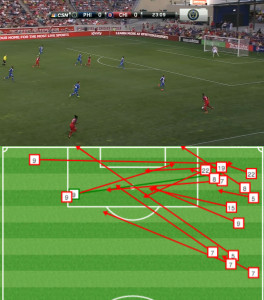
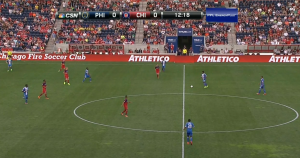


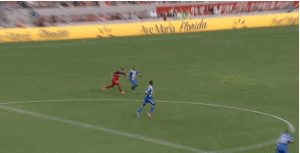
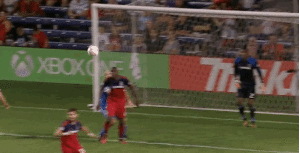
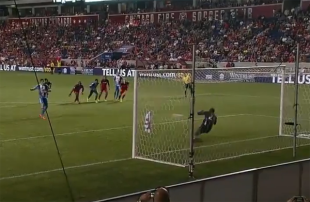

too high for Edu, in my opinion. didn’t follow his man on Chicago’s two real chances, and on the goal, stood five yards away watching… tough for someone with so much talent.
Agreed about Edu. I would add that the grade for Sheanon Williams is also too high. “Rounding into form”? I’m not seeing it.
–
Overall, not a great performance by any of the Union players. That was an ugly game to watch.
With regards Edu – surely he should have some points taken off of that 8 for losing Larentowicz not once, but twice on corners, allowing him to score?
I also wouldn’t want my winger/second striker to get an 8 for being good defensively (whether his fault or the coaches fault)
I have to agree with the other comments about Edu. A 5 at best. Take a point off for each blown coverage/chance. I would give him even lower than a 5 because of the fact that he’s our captain and highest paid player. He’s setting a bad example for the rest of the team.
@ Adam, were you watching when Edu didn’t bother to do a freaking thing when he was supposed to be man marking Larentowicz on the corners?
Edu is being paid DP money, he doesn’t want to be a CB, and he takes large chunks or entire games off.
The end of his loan can’t come soon enough.
Adam, I’m glad someone reviews the game and provides analysis of each player’s complete, 90-minute performance. If you sat next to me at the bar and saw Edu slice an uncontested shot into the stands after already having let Jeff Larentowicz burn him for what should have been 2 corner kick goals, I would have asked you what the hell he does for a living. I’ll defer to your knowledge on this one, because I laughed when I saw an 8 next to his name.
this post gets a 9 for analysis but a 3 for player ratings 😉
So I guess the switch of Gaddis to left back for the NY game wasn’t a strategic move after all. It sucks that his reward for busting his ass all season is to be played out of position…again.
I think being played on the left side can be a “reward” for Gaddis. Most teams have a stronger attack from their right side than their left, so I’d rather see Gaddis on the other team’s stronger side to shut them down.
For the reasons you say, I see how it’s best for the team. But the move to left back will hurt Gaddis’ development. He was just starting to improve going forward…
Fair criticisms of Edu on the corner. I think the bigger issue is: Why are you playing zone defense on/inside the six and leaving a huge, unmarked gap at the penalty spot. You know, the place where teams try to put corners? So I think it’s on Edu but that some of the blame has to be partitioned onto the team’s organization on that.
–
So yeah, fair criticisms. Keep ’em coming.
Williams spent very little time playing fullback and stressed the back line. He is looking horribly mediocre and hardly worth sacrificing any part of Gaddis’ game. (7?)
.
Edu looked poor. His marking was suspect and his offensive contribution was shoddy, at best. (8?)
.
White was strong defensively, with play in front of him. Once he got the ball, he gave it away…a lot. (8?)
.
I thought that, overall, our club played an awfully sloppy match. Granted, they were worn down by the busy week, but that doesn’t account for all of the misplays.
.
This was the first match where Curtin’s decisions concerned me. His subs were stale and predictable, aside from Brown’s…which would have been nice 10 minutes earlier. Casey did not need to go 60′, let alone the full 90′.
I’m not sure we were watching the same match.
i made a gif of the shipp handball if anyone is interested http://i.minus.com/ibr4dyShRSZeVn.gif
its crazy because if you watch when this first happens the ref sees it and initially points to the spot but then he chickens out and calls for a corner instead
Thanks for doing this. The one I tried to capture didn’t come out well enough for posting.
nice gif, thanks
Wow, that was Torsten Frings-like. Nicely done, Kyle.
Thanks. I watched the game from Toyota Park, and they never showed that replay. Certainly makes me feel better about the other bad call.
That could’ve easily been a red too. Wow.
Great analysis as always, Adam. I do have to disagree with one rating in particular – for someone I’m a huge fan of – Ray.
.
I thought Ray had a number (maybe 6-7) really bad/dangerous passes that could have been punished if the Fire had any capability offensively. I don’t remember a game where he’s had that many passes that had me hold my breath. Perhaps some of it was due to not having a wide option, so the center was compact. And I haven’t seen his overall stats, so I’m just going off my anecdotal reaction to the glaring mistakes, but he’s got to do better–especially against top competition. I would have rated him a 4.
Also, that video clip you showed of “Okugo not filling the space when the ball pops out,” was fine in my opinion. He had to hold that space because Sheannon had made a run up the wing. If he fills the gap, that leaves the forward free in the corner which pulls our CBs apart. Ultimately, he was caught in no-man’s land a bit, but you could see why he was hesitant to press up.
I see what you’re saying, sure. And you’re also right that, in the end, he was caught in no-man’s-land which is why the striker ends up with enough space to receive the ball (and also is why I picked that moment of the match to highlight). My argument is just that if he’s higher up the pitch, he’s contesting any loose ball in space. Which means an outlet would have to be from very deep, and very accurate.
As others have said, I find the analysis generally descriptively accurate, but the ratings generous across the board by about a point.
Agree that Edu has ability far beyond performance. If he reads 8 rating, .he would think not marking the most dangerous man on two corners, the second yielding a goal, and totaling flubbing his shot, were acceptable for Captain supposedly providing leadership. Not the only ball watcher on goal, but I don’t think he made more than head movement to follow the well placed cross.
Gaddis is currently a better RB than Williams. Since Williams has shown little going forward this year and Gaddis has shown speed on right side, I think Williams playing more defense or possibly as third CB would be better option than hindering Gaddis strengths. Gaddis refuses to go down left side because of weaker left foot.
Gaddis was also held back in his end, due to Sheanon drifting (and staying) very high up the pitch. This led to the Union playing with 3 in the back, for large stretches. (White pretty much played RB). If Chicago was on their game, we would have been very much exposed.
I think I prefer Williams on the right side. Gaddis needs to learn to play with his left foot also. I also feel like Williams gives us more options on the right then Gaddis. Don’t get me wrong Gaddis is playing great but Williams gives the Union more on the right and I like what I see. His crosses are more on point than Gaddis and he is more comfortable going forward than Gaddis. He must be doing something right since he has a goal and a couple of assists since he has been back in the right back position. How many goals does Gaddis have this year? Hey, being on the left side doesn’t mean you can’t score or have an assist. I’d like to see him put more crosses in on the left side….lets talk about that.
Williams’ goals have come off of a corner kick and a scramble after a free kick where he was still in the box when the ball was played back in. Neither of the goals have come from normal run of play. He would have been in those spots regardless of where he was playing.
.
So all of that time Williams spends “David Luiz-ing” it by running forward and leaving the rest of the defense to compensate for his absence…has gotten us one assist. Which is exactly what Ray has gotten us. Except Ray comes with the benefit of much better recovery speed and overall defense.
.
Ray Gaddis is a professional soccer player and it’s laughable that he can’t use his left foot. He won’t be the first or the last player with that problem but it’s shameful nonetheless. But if he can’t cross it with his left foot, than put him back on the right side and move Sheanon to the left. Or better yet, get a left back, move Ray to the right side, and trade Sheanon Williams.